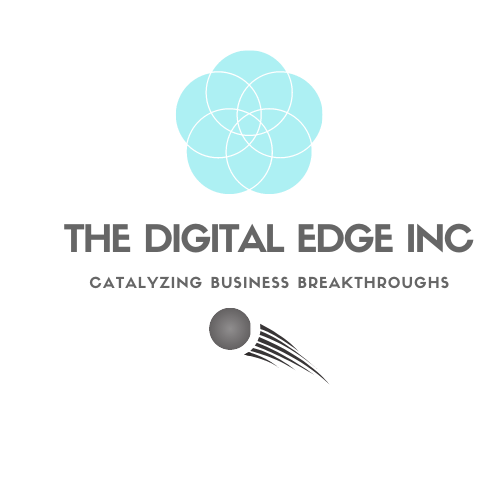Boost Sales with The Digital Edge Inc's Innovative Marketing Strategies

In today's fast-paced business world, innovative marketing strategies play a crucial role in driving sales growth. You need to adopt unique tactics to stand out and achieve substantial success. Quick and effective implementation of these strategies ensures you stay competitive. By leveraging digital tools, you gain a marketing edge that can transform your brand's reach and impact. For instance, integrating PPC, CRO, and Email can lead to a 59% increase in market-qualified leads. Embrace innovation to propel your business forward and capture the attention of your target audience.
Understanding Innovation in Marketing Strategy
Definition and Importance
What makes a marketing strategy innovative?
Innovation in marketing involves creating unique and effective strategies that set your brand apart. You achieve this by embracing new ideas and technologies that enhance your marketing efforts. An innovative marketing strategy often includes creative approaches, such as using cutting-edge digital tools or exploring unconventional channels to reach your audience. For example, Dan Gray, an expert in influencer marketing, emphasizes the power of creative approaches like using country captains to engage diverse audiences. By thinking outside the box, you can capture the attention of your target audience and drive significant growth.
Why innovation is crucial for sales growth.
Innovation is essential for sales growth because it allows you to adapt to changing market conditions and consumer preferences. When you innovate, you stay ahead of competitors and meet the evolving needs of your customers. This proactive approach leads to increased customer acquisition and retention, ultimately boosting your sales and revenue. Cristiano Winckler, known for his personalized account-based marketing techniques, highlights how tailored strategies can lead to more effective customer engagement and higher conversion rates. By prioritizing innovation, you ensure your marketing efforts remain relevant and impactful.
Key Characteristics
Creativity and adaptability.
Creativity and adaptability are key characteristics of an innovative marketing strategy. You need to be open to experimenting with new ideas and adjusting your approach based on feedback and results. This flexibility allows you to respond quickly to market changes and seize new opportunities. By fostering a culture of creativity within your team, you encourage fresh perspectives and innovative solutions that can drive your marketing success.
Integration of digital technologies.
Integrating digital technologies into your marketing strategy is crucial for staying competitive in today's digital landscape. Utilizing tools like social media platforms, marketing automation software, and data analytics can enhance your marketing efforts and provide valuable insights into customer behavior. By leveraging these technologies, you can streamline your marketing workflows, improve social media management, and create more targeted and effective campaigns. This integration not only boosts your marketing efficiency but also helps you achieve your sales goals and revenue targets.
Quick Implementation Steps for Sales Strategy
To boost your sales, you need a well-defined sales strategy. Implementing this strategy quickly and effectively can give you a competitive edge. Here’s how you can do it:
Setting Clear Goals
Aligning marketing objectives with business goals.
Your marketing objectives should align seamlessly with your business goals. This alignment ensures that every marketing effort contributes directly to your overall sales strategy. By doing so, you create a cohesive plan that drives your sales process forward. For instance, if your business goal is to increase market share, your marketing strategy should focus on expanding your audience reach and engagement.
Establishing measurable targets.
Setting measurable targets is crucial for tracking the success of your sales strategy. These targets provide a clear benchmark for evaluating your marketing efforts. Use specific metrics like sales growth percentage, customer acquisition rate, or lead conversion rate. By establishing these targets, you can monitor progress and make necessary adjustments to optimize your sales process.
Identifying Target Audiences
Conducting market research.
Market research is the foundation of any successful sales strategy. It helps you understand your target audience's needs, preferences, and behaviors. Conduct thorough research to gather insights into market trends and consumer demands. This information allows you to tailor your marketing strategy to meet the specific needs of your audience, enhancing your sales process.
Creating detailed customer personas.
Creating detailed customer personas is essential for targeting your audience effectively. These personas represent your ideal customers and include demographic information, interests, and buying behaviors. By understanding your target audience on a deeper level, you can craft personalized marketing messages that resonate with them, ultimately driving sales.
Leveraging Digital Tools in Marketing
Utilizing social media platforms.
Social media platforms are powerful tools for reaching a wider audience quickly. They allow you to engage with your target audience directly and build brand awareness. Use platforms like Facebook, Instagram, and LinkedIn to share content, run targeted ads, and interact with potential customers. Effective social media management can significantly enhance your marketing workflows and boost your sales strategy.
Implementing marketing automation software.
Marketing automation software streamlines your marketing workflows and improves efficiency. It automates repetitive tasks like email campaigns, lead nurturing, and customer follow-ups. By implementing this software, you can focus on strategic activities that drive sales. Automation also provides valuable data insights, helping you refine your sales strategy and achieve better results.
By following these steps, you can implement a robust sales strategy that leverages digital tools and aligns with your business goals. This approach not only enhances your marketing efforts but also drives significant sales growth.
Practical Advice and Examples
Case studies of successful implementations.
To truly understand the power of an effective sales strategy, let's explore some real-world examples. Consider a company that shifted from traditional marketing to digital marketing. This transition allowed them to reach a wider audience faster and more cost-effectively. By leveraging online platforms, they engaged with their target audience in a more interactive manner. This approach not only increased their brand visibility but also significantly boosted their sales and revenue.
Another example involves a business that integrated marketing automation software into their sales strategy. This move streamlined their marketing workflows and improved efficiency. The automation of repetitive tasks freed up time for strategic activities, leading to a more focused and effective sales process. As a result, they saw a marked increase in customer acquisition and retention.
Tips for overcoming common challenges.
Implementing a new sales strategy can present challenges. However, with the right approach, you can overcome these obstacles and achieve success. Here are some practical tips:
Embrace Digital Marketing: Digital marketing offers a more direct way to connect with global audiences. It's generally more cost-effective than traditional marketing methods. By utilizing digital tools, you can target your audience more precisely and achieve a higher return on investment.
Stay Adaptable: The market is constantly changing. You need to be flexible and ready to adapt your strategy as needed. This adaptability will help you stay ahead of competitors and meet the evolving needs of your customers.
Focus on Customer Experience: Simplifying the purchasing process can enhance the customer experience. Make it easy for customers to find what they need and complete their purchase. This focus on customer satisfaction can lead to increased sales and revenue.
Measure and Optimize: Use analytics to track the performance of your marketing efforts. Identify key performance indicators (KPIs) that align with your sales strategy. Regularly review these metrics and make necessary adjustments to optimize your strategy.
By following these tips, you can navigate the challenges of implementing a new sales strategy and drive significant growth in your sales and revenue.
Measuring Success and Adapting Marketing Strategies

To ensure your marketing efforts yield the desired results, you must measure success and adapt your strategies accordingly. This process involves identifying key performance indicators (KPIs) and using analytics to track progress. By doing so, you can refine your marketing implementation plan and achieve your sales goals.
Key Performance Indicators (KPIs)
Identifying relevant KPIs for marketing efforts.
Selecting the right KPIs is crucial for evaluating your marketing strategy. These indicators provide insights into how well your marketing implementation aligns with your business objectives. For instance, tracking metrics like conversion rates, customer engagement, and brand awareness can help you assess the effectiveness of your marketing content. By focusing on these KPIs, you can determine whether your marketing efforts are driving sales and revenue growth.
Using analytics to track progress.
Analytics play a vital role in monitoring your marketing implementation plan. They offer a detailed view of your marketing performance, allowing you to identify trends and patterns. For example, LinkedIn observed a 75% increase in open rates and an over 800% surge in conversions by analyzing their marketing data. By leveraging analytics, you can make informed decisions and adjust your marketing strategy to better meet the needs of your target customers.
Adapting Based on Results
Iterating strategies for continuous improvement.
Continuous improvement is key to maintaining a successful marketing strategy. You should regularly review your marketing results and make necessary adjustments. This iterative approach ensures that your marketing implementation remains effective and aligned with your sales strategy. For example, Info-Tech revamped its SEM strategy using Sponsored Content, leading to a 42% click-to-conversion rate for qualified leads. By iterating your strategies, you can enhance your marketing efforts and achieve better results.
Learning from failures and successes.
Every marketing campaign offers valuable lessons. By analyzing both failures and successes, you can gain insights into what works and what doesn't. This knowledge allows you to refine your marketing implementation plan and improve your sales performance. For instance, Plexus achieved a 20% increase in monthly sales qualified leads by learning from past experiences and adapting their marketing techniques. Embrace these lessons to drive your brand's growth and reach your revenue targets.
By focusing on KPIs, utilizing analytics, and adapting your strategies based on results, you can optimize your marketing implementation plan. This approach not only enhances your marketing efforts but also drives significant sales and revenue growth. Stay proactive and continuously refine your strategies to ensure your brand remains competitive in the global marketing strategy landscape.
Innovative marketing strategies are essential for driving sales growth and achieving your business objectives. By embracing these strategies, you position your brand to capture the attention of your audience and enhance your marketing efforts. The outlined steps provide a clear path for you to implement these strategies effectively. Take action with confidence, knowing that digital tools can transform your marketing landscape. As you integrate these techniques, you will see improvements in audience engagement and content creation, ultimately leading to increased revenue and success.
See Also
Essential Strategies for Gaining Leadership Support in Marketing

